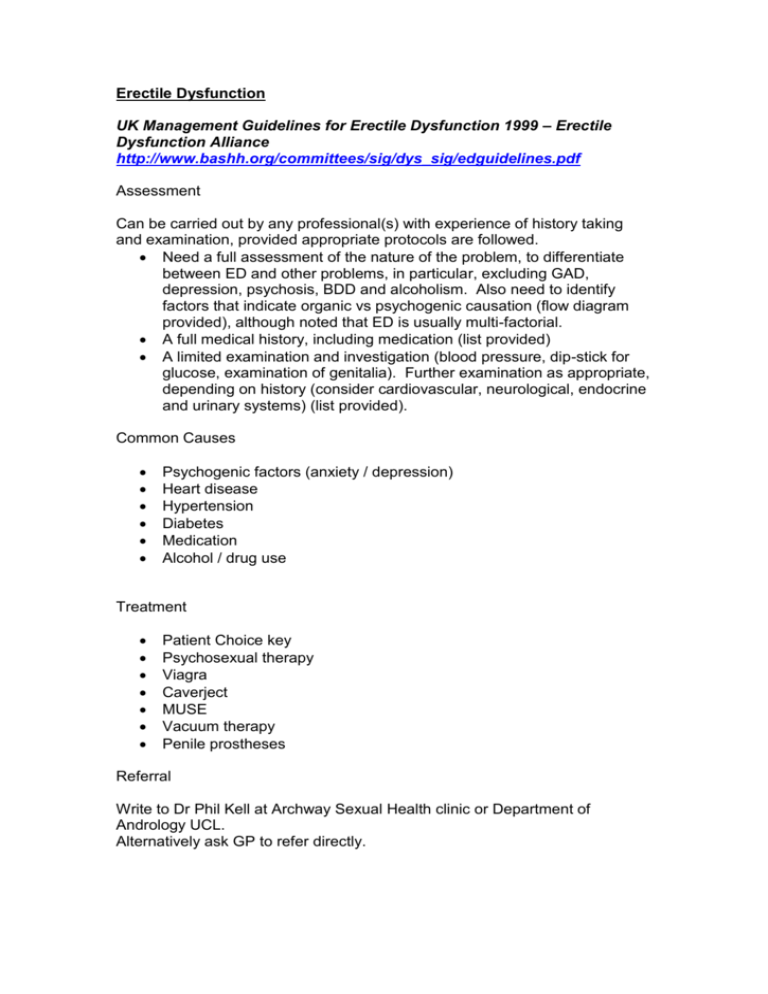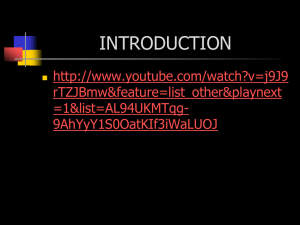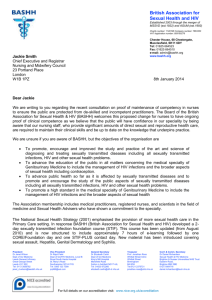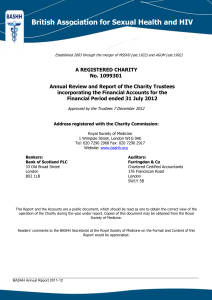
Erectile Dysfunction
UK Management Guidelines for Erectile Dysfunction 1999 – Erectile
Dysfunction Alliance
http://www.bashh.org/committees/sig/dys_sig/edguidelines.pdf
Assessment
Can be carried out by any professional(s) with experience of history taking
and examination, provided appropriate protocols are followed.
Need a full assessment of the nature of the problem, to differentiate
between ED and other problems, in particular, excluding GAD,
depression, psychosis, BDD and alcoholism. Also need to identify
factors that indicate organic vs psychogenic causation (flow diagram
provided), although noted that ED is usually multi-factorial.
A full medical history, including medication (list provided)
A limited examination and investigation (blood pressure, dip-stick for
glucose, examination of genitalia). Further examination as appropriate,
depending on history (consider cardiovascular, neurological, endocrine
and urinary systems) (list provided).
Common Causes
Psychogenic factors (anxiety / depression)
Heart disease
Hypertension
Diabetes
Medication
Alcohol / drug use
Treatment
Patient Choice key
Psychosexual therapy
Viagra
Caverject
MUSE
Vacuum therapy
Penile prostheses
Referral
Write to Dr Phil Kell at Archway Sexual Health clinic or Department of
Andrology UCL.
Alternatively ask GP to refer directly.
Premature Ejaculation
BASHH summary – 2006
http://www.bashh.org/committees/sig/dys_sig/bashh_pe_recomm_05010
6.pdf
Definition:
A universally accepted definition yet to be established.
Persistent or recurrent ejaculation with minimal sexual
satisfaction before or shortly after penetration and before a
person wishes. Resulting in distress/interpersonal difficulties.
Prevalence: A systematic review suggested a prevalence of 15%
Assessment
Drug / alcohol use
Expectations, including cultural factors
Degree of control
Degree of distress, including cultural meanings (may not be a problem)
Primary (life long) or secondary (acquired)
Context for sex (where, when, with whom)
Quality of relationship and communication
Anxiety / depression and other psychiatric history
Sexual desire
Erectile difficulties
Urinary symptoms
Prostatitis symptoms
Clinical examination
General physical state / health
Organic Causes
Chronic prostatitis
Neurological disease
Pelvic injury
Vascular disease
Prostatic hypertrophy
Hypogonadal hypertrophy
Interventions
Treat erectile dysfunction and/or underlying cause first
Treatment on case by case basis ‘eclectic approach’
Education
Discussion of sexual norms
Facilitation of sexual negotiation
Squeeze technique / stop-start / sensate focus – limited treatment
gains longer term
EMLA cream & SSRIs (not licensed) – no lasting effects
Pelvic floor exercises (no formal trials)
Referrals
Write to Dr Phil Kell at Archway Sexual Health clinic or Department of
Andrology UCL.
Alternatively ask GP to refer directly.
Retarded Ejaculation
BASHH summary – 2006
http://www.bashh.org/committees/sig/dys_sig/bashh_re_recomm_05010
6.pdf
Definition:
The persistent or recurrent difficulty, delay in or absence of
attaining orgasm following sufficient sexual stimulation causing
personal distress.
Prevalence: A UK population based survey of 5000 16-44 year olds
suggested a prevalence of 5%. Reduces with increasing age.
Assessment
Orgasmic and/or ejaculatory problem
Sexual desire, erectile difficulties
Personal, social, cultural issues
Brief psychiatric / medical history
Prescribed and non-prescribed drugs, including alcohol
Clinical examination of penis & nervous system (exclude peripheral
neuropathy autonomic dysfunction & spinal cord pathology)
Serum glucose / investigation of nervous disease as appropriate
Organic Causes
Spinal cord injury
Retro-peritoneal lymph node dissection
Diabetes mellitus
Trauma / retroperitoneal surgery
MS
Radical prostatectomy or bladder neck surgery
Abdominal/pelvic surgery including abdominal aortic aneuysmectomy
Peripheral vascular disease
Mullerian and Wolfian duct malformation
Bilateral sympathectomy
Hypogonadism
Hypothyroidism
Drugs implicated in RE
Alcohol
Alpha blockers
Adrenergic Neurone Blockers
Anti-psychotics
Atypical anti-depressants (trazodone)
Beta blockers
Baclofen
Benzodiazepines
Mono-amine oxidase inhibitors (MAOIs)
Naproxen
Opiates
Selective serotonin re-uptake inhibitors
Thiazides diuretics
Tricyclic anti-depressants
Interventions
Treat erectile difficulties first.
Treat case by case: an eclectic approach
Changing pharmacological agents if possible
There is limited evidence for adding agents (not licensed for this):
Level III evidence for amantadine for fluoxetine induced RE
Level III evidence for bupropion for SSRI induced RE, Level Ib for
buspirone
Level III evidence for cyproheptadine for imipramine, nortryptiline,
fluoxetine, fluvoxamine, clomipramine & citralopram induced RE, but
can cause drowsiness, which can affect sexual functioning.
Level III evidence for yohimbine for clomipramine, fluvoxamine,
fluoxetine, sertraline & paroxetine induced RE
Level III & IV evidence for sex therapy. Meta-analysis success 42% - 82%
Can include sexual fantasy, masturbation exercises, use of sex aids,
relaxation and addressing anxieties (eg fears of pregnancy, STIs)
Level IV evidence for hypnosis
Referrals
Write to Dr Phil Kell at Archway Sexual Health clinic or Department of
Andrology UCL.
Alternatively ask GP to refer directly.
Vaginisimus
BASHH summary – 2006
http://www.bashh.org/committees/sig/dys_sig/bashh_vag_recomm_0501
06.pdf
Definition:
Recurrent or persistent involuntary spasm of the musculature of
the outer third of the vagina that interferes with coitus and
causes distress/interpersonal difficulty.
Prevalence: Common. Prevalence among general population unknown.
Assessment
Early traumatic sexual experiences
Sexual assault
Traumatic physical examinations
Sex education
Familial, religious and cultural beliefs
Relationship
Social circumstances
Medical history (particularly contraception, GUM & O&G problems)
Description of pain, fear of pain, avoidance responses.
Use of tampons.
Sexual history (problem primary, secondary, situational, global)
Genital examination to exclude organic pathology. Pelvic examination
only if seems appropriate (note presence of spasm / distress), but can
be extremely unhelpful if woman not ready.
Attitude to own genitals, self-touching and masturbation.
Organic Causes
UTIs
Vestibulitis
Post-menpausal oestrogen deficiency
Genital surgery trauma (eg episiotomy)
Radiotherapy
Arousal difficulties related to diabetes, MS or spinal cord injury
Interventions
MDT. Overlap with vulvar vestibulitis syndrome and dyspareunia.
Individualised approach, limited scientific evidence.
Check treatment goals – penile-vaginal intercourse may not be the
desired outcome
Treatment with woman and partner if possible.
Education
Self-examination
Pelvic floor exercises
Behavioural and desensitisation techniques
Graded penetration (eg with dilators) with relaxation
Sensate focus
Psychotherapy
Couple therapy
Choice of gender or physician / therapist
Level III evidence for insertion training (success rates 72% to 100%, with 2-15
sessions)
Referrals
To Dr Helen Mitchell in Female Problem Clinic










